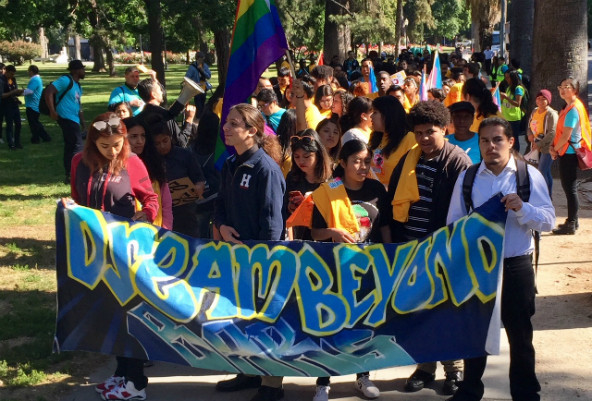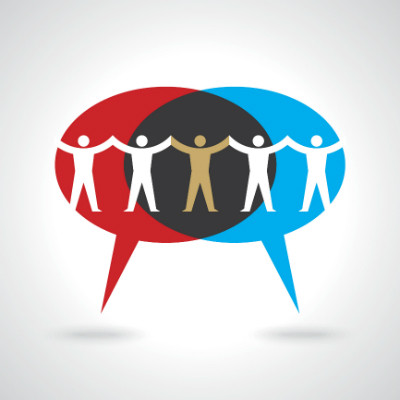For years intellectuals have wrung their hands about how to sustain a vast, vigorous civil society in an increasingly diverse nation. But today, millions of people—activists of color, youth, and women especially—are taking multi-pronged action to defend civil rights, democratic values, and norms of decency. In my 40-plus years as a professional in civil society, I have never seen such an energized populace working to advance America’s highest ideals of justice, inclusion, fairness, and opportunity for all. Now a deeper, more exhilarating question arises: Can robust civic engagement, grounded in the quest for full inclusion and equity, produce an authentic, modern-day civil society that redefines the public good and ushers in a 21st-century social compact?
Alexis de Tocqueville rightly recognized that a uniquely American public spirit was required to sustain the democratic experiment. He viewed civil society as a check on tyranny and despotism, and a driver of community. But the goals of civil society have always been amorphous, and its nature and composition have changed with the times and shifting power relations. De Tocqueville’s exhaustive account of the best and the ugliest in the nation reminds us there is nothing inherently good about civil society. The good lies in how and for whom it is put to work.
 Youth making their voices heard at the State Capitol in Sacramento, California, during a day of action at the annual Free Our Dreams Summit. (Photo by Chione Flegal, PolicyLink)
Youth making their voices heard at the State Capitol in Sacramento, California, during a day of action at the annual Free Our Dreams Summit. (Photo by Chione Flegal, PolicyLink)

At the time of de Tocqueville’s observations before the Civil War, American civil society was the exclusive domain of White men. He saw citizen associations empower those it served while, for the most part, defending the brutal oppression of others: slavery in the South, anti-Black prejudice and exclusion in the North, and the slaughter of Native Americans.
For 150 years after de Tocqueville’s tour, countless organizations and institutions professed to serve the public good, yet defined it in ways that protected White male power and justified discrimination and exclusion. Private societies and clubs shut out all but a select few—a bulwark against the threat to the status quo posed by women, African Americans, impoverished immigrants, Jews, and Catholics.
The Ku Klux Klan illustrates this dynamic in its hateful extreme. People took private action to guard what they deemed as the public good, White supremacy, and to do so by any means necessary, including intimidation and violence.
But even in mainstream civil society, exclusion and prejudice ruled. Some people may look at earlier generations as models of selfless community spirit, but the nation’s most prestigious and influential professions, institutions, and systems that purported to advance the public good—academia, civic leadership, and other pillars of civil society—remained the preserve of White men through most of the 20th century. And many did not open their doors without a fight.
As courts threw out racial zoning, school segregation, and other forms of legal racial separation, organizations such as homeowner councils, neighborhood associations, and parent groups flowered to achieve the same result—keep out Blacks and other “undesirables.”
Many other associations—men’s leagues, garden and glee clubs—formed under a more benign guise but a similar impulse: maintaining the White world in which White people wanted to live. They advanced a segregation agenda without bloodshed, but with exclusionary intent so deeply ingrained that most members could tell themselves they were simply engaging with their own kind in recreation, charity, prayer, or self-improvement. Racial, religious, and ethnic minorities were free, and in many cases encouraged and supported, to form their own leagues, churches, teams, and scout troops. But tolerance stopped at the locked gates of White clubs.
Civil rights laws tamped down bald discrimination and the most vicious displays of prejudice, at least until recently. Yet the entrenched structures of racism maintain two separate and shamefully inequitable societies: one, largely White, characterized by opportunity; the other, disproportionately of color, characterized by poverty and nearly frozen mobility. This divide, in the context of a profound demographic shift, has pushed the leading edge of civil society from a quest for equality, or ensuring that everyone has the same legal rights, to a quest for equity—promoting just and fair inclusion and creating the conditions in which all can reach their full potential.
There is a deeply held idea of civil society as a space of polite discourse and benevolent action. But in the current political climate, as the federal government turns its back on the most vulnerable and tries to erase decades of progress toward inclusion, private action for the public good must be fierce, even confrontational. The Dreamers, Black Lives Matter, the high school students acting in solidarity with those affected by the shooting in Parkland, Florida, the Women’s March, #MeToo, and many others are often dismissed as too disruptive, too political, overly focused on narrow concerns of race and identity. In fact, they embody the public spirit hailed by de Tocqueville. And they stand on the shoulders of courageous, determined leaders throughout American history—through the American Revolution, women’s suffrage, and the civil rights movement—who by turns have built a better, fairer, stronger nation, always against furious opposition.
Like Elizabeth Cady Stanton or Martin Luther King, Jr., leaders of today’s movements are defining the edge of civil society as a fight to upend the systems and institutions that hold people back, and to create a society in which all can participate, contribute, and thrive.
It brings to mind these questions: What are the goals of civil society in a diverse, divided democracy at a moment of political crisis? Who determines those goals and the right strategies to achieve them? Whose voice, experience, and actions should command attention, respect, and funding? Perhaps most challenging, how can those who understand the transformative possibilities of an engaged civil society cross the divides of race, generation, and style to make space for the vital, stinging conversations and actions that are essential at this moment?
The work of civil society cannot be top down. It requires the full participation and leadership of people who bear the brunt of society’s greatest challenges. A young generation—exercising its agency, leading on issues shaping the future, and finding solidarity across lines of race, ethnicity, ability, gender, sexual orientation—must be heard as they speak their truth. Only through that prophetic dialogue can civil society move the nation to address the deep, increasingly toxic fissures in economic, political, and civil life.
The recent wave of protests and resistance efforts have gotten most of the attention, but in my travels around the country, I also see innumerable examples of low-income people, people of color, and youth working to build communities and a nation that work for all. These communities need more than glee clubs, garden societies, and philosophical discourse to improve and enrich lives. In Pittsburgh and other resurgent cities, residents are organizing their neighbors and spearheading initiatives to make sure new investment does not displace longtime residents but benefits all. The potent, youth-led Alliance for Boys and Men of Color in California has won passage of dozens of state bills and local policies to strengthen communities and improve the life chances for millions of young people. Around the country, young people are taking on sex trafficking, lifting it up as a crisis and providing desperately needed support for individuals. In a similar vein, activists are working tirelessly to reduce gun violence, not only the mass shootings that garner headlines, but also the daily devastation in communities of color.
Efforts like these define what government and the business sector should be doing in a diverse nation with epic inequality, and barriers that prevent millions of people from participating in economic, political, and civic life. These efforts, fueled by the radical imagination of contemporary civil society stewards, are modeling what society must do: authentically engage diverse communities to articulate problems, determine priorities and solutions, and create a just, inclusive nation—an America that shows the world what equitable democracy looks like.
This series aims to spark conversation and provide a place where diverse thinkers can propose, discuss, and iterate their understanding of the role that civil society plays in 21st century America. We encourage all readers to actively participate in discussion in the comments areas. SSIR and Independent Sector has also included a limited number of crowdsourced articles in the series.
Listen to Independent Sector's Civil Renewal podcast. In this episode, Dan Cardinali is joined by Pastor Samuel Rodriguez, president of the National Hispanic Christian Leadership Conference.
Support SSIR’s coverage of cross-sector solutions to global challenges.
Help us further the reach of innovative ideas. Donate today.
Read more stories by Angela Glover Blackwell.

